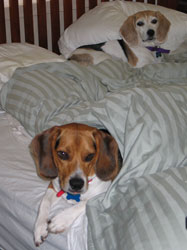


The Beagle is considered to be one of the oldest breeds in history. The exact origins of the breed are lost to time; however, it is known that the ancient Greeks and Romans had small hounds that hunted by scent as far back as 400 B.C. The Romans are thought to have transported small hunting hounds to England and bred them with local hounds.
By the 1400s, these small scent-hounds began to be referred to as Beagles, and were used for the hunting of rabbits and other small game. Around this time, Beagles also started to become popular with English nobility; Edward II, Henry VII, and Elizabeth I all kept packs of Beagles for use in the hunt. By the late 1700s, rabbit hunting fell out of favor as foxhunting increased in popularity. Consequently, the larger Foxhound began replacing the Beagle as the English nobility's hunting dog of choice. Fortunately, farmers throughout the British Isles preserved the breed by continuing to keep packs of Beagles to hunt with. In the mid 1800s, Rev. Phillip Honeywood established a pack in Essex, England that is thought to be the progenitor of the modern Beagle. However, Honeywood bred for hunting ability, rather than looks; a fellow Englishman, Thomas Johnson, bred Beagles on the basis of their hunting ability and attractive appearance.
Early Beagles in America were more like Basset Hounds or Dachshunds than the Beagles we know today; the turning point for the American breed came in the 1870s, when enthusiasts imported high-quality English Beagles and began to keep careful track of breeding and bloodlines. The American Kennel Club first registered a Beagle in 1885, and the National Beagle Club was founded in 1888.
Today, Beagles are still used for hunting rabbits and other small game, but they are now primarily kept as pets; their general friendliness and sweet disposition makes them excellent family companions and one of America's most popular breeds. Because of their acute sense of smell, Beagles have also found a place as working dogs. Law enforcement and customs use the Beagle to sniff out drugs and other illegal contraband; their small size and friendly appearance make them ideal dogs for working in front of the public, who find them less intimidating than German Shepards or other large dogs. The Beagle's nose has also been used by arson investigators to discover the use of accelerants, and by exterminators to find termite infestations!
Source material: